As I said, I don't know your library.
But here's what I understand:
A user enters several options into your pages GUI, and you use the library to generate a report. The library returns the url for that report. If the user returns to the page, you want them to be-able to plugin the URL and the GUI will return to the state it was in when the report was generated (all the selected items and stuff are as they were).
Best solution, if possible
If somehow the URL or something has data you can parse those fields form that's probably best.
Another solution if you have a backend
You could store in a database a table with "url", and a column for each of the fields. When they generate a report it makes a request to the backend which then inserts into the table a row with the URL generated and the values they entered.
When they return to the page and enter a URL just make a request to the backend that returns the row that matches the url. (eg. select * from generated_reports where url='queryUrl')
If your app is frontend app only (no backend)
You could store it in browser localstorage:
Example:
var assigned_fields = {
tables_selected: ["user", "cats", "dogs"]
}
var report_url = "http://not-really.com"
window.localStorage.setItem("report_"+report_url, JSON.stringify(assigned_fields))
function getAssignedFieldsFromURL(url) {
return JSON.parse(window.localStorage.getItem("report_"+url))
}
Notice that if you run this javascript in the console you can use:
getAssignedFieldsFromURL("http://not-really.com")
This will return the object even after a page refresh.
This solution will not work if they use a different browser or a different computer.
You can use the library of your choice or native javascript to populate the assigned fields object, and to populate the GUI from the object. If you want more information on that step, comment and I'll add it.
Parsing the URL
I got this from: How do I parse a URL query parameters, in Javascript?
I changed it to take a url as a param
function getJsonFromUrl(str) {
var query
var pos = str.indexOf("?")
if (pos !== -1)
query = str.substr(pos+1)
else
query = str
var result = {}
query.split("&").forEach(function(part) {
if (!part)
return
part = part.split("+").join(" ") // replace every + with space, regexp-free version
var eq = part.indexOf("=")
var key = eq>-1 ? part.substr(0,eq) : part
var val = eq>-1 ? decodeURIComponent(part.substr(eq+1)) : ""
var from = key.indexOf("[")
if (from == -1)
result[decodeURIComponent(key)] = val
else {
var to = key.indexOf("]")
var index = decodeURIComponent(key.substring(from+1,to))
key = decodeURIComponent(key.substring(0,from))
if(!result[key]) result[key] = []
if(!index) result[key].push(val)
else result[key][index] = val
}
})
return result
}
Example Usage:
getJsonFromUrl("http://google.com?test=5&cat=3")
Returns: Object {test: "5", cat: "3"}
With that you can hopefully get the information you want form the query params
Note:
You may want to ensure this is parsing correctly. I noticed it transforms all "+" to " " and some other things.
